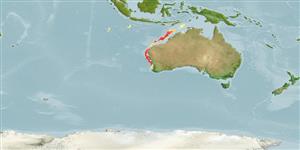分類 / Names
共通名の | 類義語 | Catalog of Fishes(部類, 種) | ITIS | CoL | WoRMS | Cloffa
板鰓亜鋼(サメとエイ類) (sharks and rays) >
Carcharhiniformes (Ground sharks) >
Scyliorhinidae (Cat sharks) > Scyliorhininae
Etymology: Cephaloscyllium: cephalus, from kephale (Gr.), head, referring to its very broad and depressed head; skylion, Greek for dogfish or small shark. (See ETYFish); speccum: From specca (L.), speckled, referring to dark brown spots and blotches that dominate its color pattern. (See ETYFish).
More on authors: Last, Séret & White.
Environment: milieu / climate zone / depth range / distribution range
生態学
海 底生の漂泳性; 深さの範囲 150 - 455 m (Ref. 76946). Tropical
Eastern Indian Ocean: Australia.
Length at first maturity / サイズ / 重さ / 年齢
Maturity: Lm ?, range 64 - ? cm
Max length : 68.0 cm TL オス/雌雄の選別がない; (Ref. 76946); 69.4 cm TL (female)
簡単な記述
検索表 | 形態学 | 形態計測学
A medium-sized species with the following characters: head 7.8-12.5% TL in height, trunk width 13.0-16.8% TL; origin of first dorsal-fin mostly over posterior of pelvic-fin base; prenarial 3.6-4.9% TL in length; preorbital snout length 1.5-2.0 times prenarial length, 2.6-3.1 in prepectoral length, 5.9-7.1 in prepelvic length; snout-vent length long, 47.4-51.1% TL; nostril 2.2-2.7% TL in width; eye-spiracle space narrow, 0.4-1.0% TL; pectoral fin medium-sized, height 8.9-13.8% TL, posterior margin 8.5-13.3% TL; anal fin tall, 3.2-4.4% TL; anal-caudal space 4.5-6.1% TL; precaudal 76-78% TL in length; interdorsal space 6.5-8.6% TL; teeth have 3-5 cusps; unicuspidate or weakly tricuspidate flank denticles; back with no greatly enlarged denticles; adult clasper long, outer length about 7% TL, well short of anal fin, interspace about 1.9% TL; vertebral centra 111-115; tooth count relatively high, 69-97 teeth in each jaw; color of upper half of body pale, with a strongly variegated pattern that is well-demarcated from the ventral surface; dark saddles (8) evident on body and caudal fin; pale variegated dorsal fins; dark blotch over gills absent; distinct V-shaped marking on posterior margin of terminal lobe of caudal fin absent; upper surfaces of pectoral and pelvic-fin without a dark central blotch; without dark saddle extending onto caudal peduncle above origin of ventral lobe of caudal fin; uniformly pale on the ventral surface; color of juveniles pale, with dark lines and spots forming rosettes and linear saddle markings, and the markings between spiracles separated into two unconnected pseudo-ocelli (Ref. 76946).
Life cycle and mating behavior
Maturities | 繁殖 | Spawnings | Egg(s) | Fecundities | 幼生
Last, P.R., B. Séret and W.T. White, 2008. New swellsharks (Cephaloscyllium: Scyliorhinidae) from the Indo-Australian region. In Last, P.R., White, W.T. & Pogonoski, J.J. (eds.): Descriptions of New Australian Chondrichthyans. CSIRO Marine and Atmospheric Research Paper no. 22. (Ref. 76946)
Human uses
用具
特記事項
XMLをダウンロードして下さい
インターネットの情報源
Estimates based on models
Preferred temperature (Ref.
123201): 11.4 - 16.5, mean 13.4 °C (based on 21 cells).
Phylogenetic diversity index (Ref.
82804): PD
50 = 0.5000 [Uniqueness, from 0.5 = low to 2.0 = high].
Bayesian length-weight: a=0.00263 (0.00139 - 0.00497), b=3.21 (3.04 - 3.38), in cm total length, based on LWR estimates for this (Sub)family-body shape (Ref.
93245).
栄養段階 (Ref.
69278): 4.1 ±0.5 se; based on size and trophs of closest relatives
回復力 (Ref.
120179): 低い, 4.5年~14年の倍増期間の最小個体群 (Preliminary low fecundity).
Fishing Vulnerability (Ref.
59153): Moderate to high vulnerability (48 of 100).
